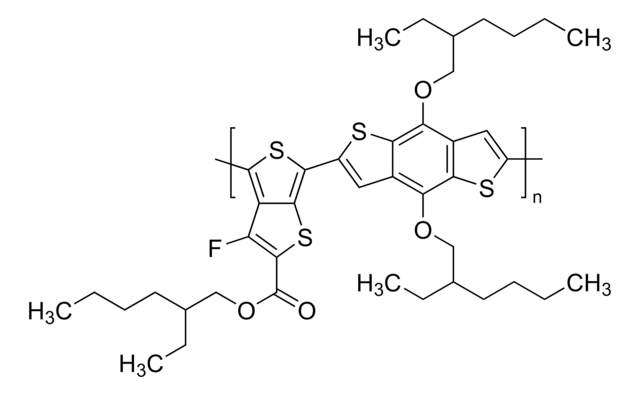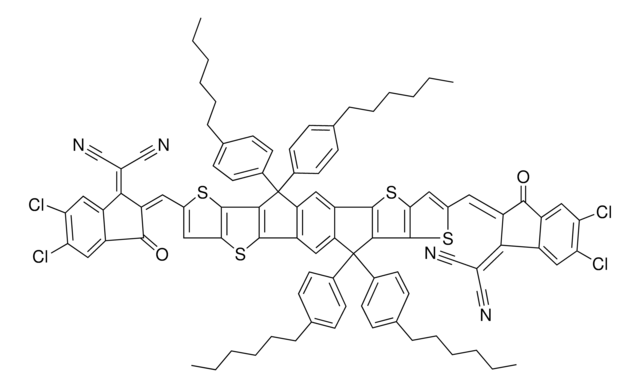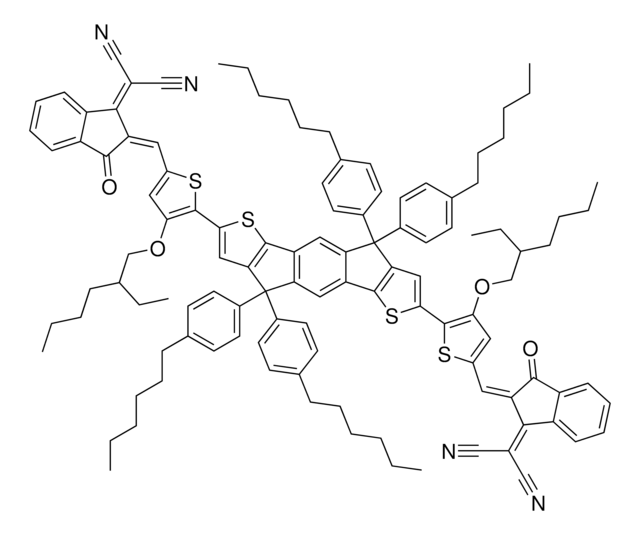910635
IDT-2Br
≥99%
Synonym(s):
5,5′-[[4,4,9,9-Tetrakis(4-hexylphenyl)-4,9-dihydro-s-indaceno[1,2-b:5,6-b′]dithiophene-2,7-diyl]bis(2,1,3-benzothiadiazole-7,4-diylmethylidyne)]bis[3-ethyl-2-thioxo-4-thiazolidinone], IDT-BT-R
About This Item
Recommended Products
description
Band gap: 1.83 eV
Assay
≥99%
form
solid
mol wt
1518.20 g/mol
color
dark
solubility
chloroform: soluble
Orbital energy
HOMO -5.52 eV
LUMO -3.69 eV
General description
Application
Ternary blend organic solar cells (OSCs) with photoresponses beyond 1000 nm can be fabricated using PTB7-Th as donor and ultralow-bandgap F8IC and medium-high bandgap IDT-2BR as NFAs. A PCE of 12.1% has been achieved by such a ternary device with 20% IDT-2BR content in acceptors. In this work, IDT-2BR was found to contribute simultanously to the improvement of the open-circuit voltage (VOC), short-circuit (JSC) and fill factor (FF) of the PTB7-Th/F8IC blend, due to smaller energy offset for charge separation, suppressed charge recombination, and imporved light absorption. Improved packing due to the coexsitence of F8IC and IDT-2BR leads to higher mobilities and more balanced charge transport, which contribute to the improved FF as well.
Additionaly, blends with IDT-2BR have been found to be thermally stable at 150 Celsius.
A ternary blend using both IDT-2BR and fullerene based acceptor: PC71BM (Product No. 684465) has also reached a PCE over 12%.
Storage Class Code
13 - Non Combustible Solids
WGK
WGK 3
Flash Point(F)
Not applicable
Flash Point(C)
Not applicable
Certificates of Analysis (COA)
Search for Certificates of Analysis (COA) by entering the products Lot/Batch Number. Lot and Batch Numbers can be found on a product’s label following the words ‘Lot’ or ‘Batch’.
Already Own This Product?
Find documentation for the products that you have recently purchased in the Document Library.
Articles
Professor Chen (Nankai University, China) and his team explain the strategies behind their recent record-breaking organic solar cells, reaching a power conversion efficiency of 17.3%.
Our team of scientists has experience in all areas of research including Life Science, Material Science, Chemical Synthesis, Chromatography, Analytical and many others.
Contact Technical Service







